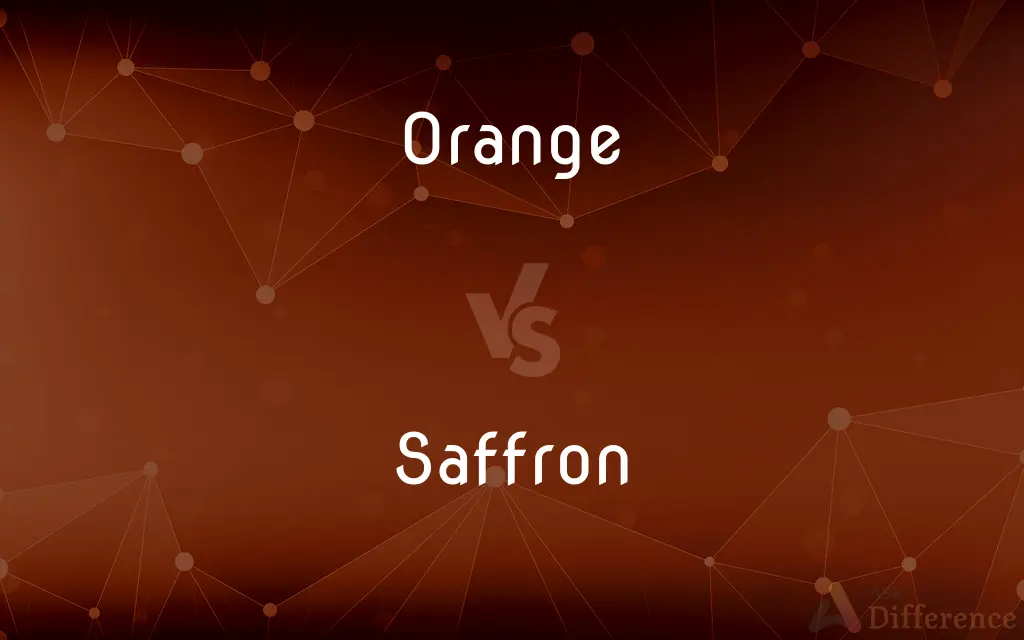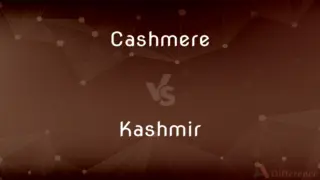Orange vs. Saffron — What's the Difference?
By Tayyaba Rehman — Updated on October 16, 2023
Orange is a citrus fruit and color, while saffron is a spice derived from the Crocus sativus flower and a shade of yellow-orange. The two terms can also have cultural or symbolic significance.

Difference Between Orange and Saffron
Table of Contents
ADVERTISEMENT
Key Differences
Orange refers to both a fruit and a color. This fruit is part of the citrus family and is known for its sweet and tangy flavor. On the other hand, saffron is a prized spice made from the dried stigmas of the Crocus sativus flower. Both are unique in their roles and significance in various cuisines and cultures.
When discussing color, orange is a vibrant hue located between red and yellow on the color spectrum. Saffron, in contrast, is a specific shade of yellow-orange, reminiscent of the color of the spice itself. Both colors can evoke feelings of warmth, energy, and vitality.
Beyond food and color, orange and saffron have cultural and symbolic meanings. For instance, in some cultures, orange is associated with joy and creativity. Saffron, especially in India, is symbolic of purity, sacrifice, and spirituality, often worn by monks and holy men.
In the political sphere, particularly in India, saffron has implications tied to Hindu nationalism. Orange, in different contexts, might be associated with specific movements or ideologies but lacks the strong religious connotations that saffron holds in certain cultures.
Lastly, while orange is a more general term with varied applications, saffron is more specialized. Whether in cuisine, color, or cultural significance, saffron has a niche presence, whereas orange has broader uses and interpretations.
ADVERTISEMENT
Comparison Chart
Nature
A citrus fruit and a color.
A spice and a shade of color.
Derived from
Citrus sinensis tree.
Crocus sativus flower.
Cultural Significance
Often tied to joy and creativity.
Linked to spirituality and purity.
Use in Cooking
Adds flavor and zest to dishes.
Imparts color and unique taste.
Price
Generally affordable.
One of the most expensive spices.
Compare with Definitions
Orange
A citrus fruit known for its vibrant color and tangy flavor.
I peeled the orange and enjoyed its juicy segments.
Saffron
A symbol of purity and spirituality in certain cultures.
Monks in India often wear saffron-colored robes.
Orange
A town in southern France, on the River Rhône, home of the ancestors of the Dutch royal house.
Saffron
A term that can symbolize certain political or religious ideologies, especially in India.
The rise of the saffron brigade marked a shift in the country's politics.
Orange
Relating to the Orange Order
Orange marches
Saffron
Saffron (pronounced or ) is a spice derived from the flower of Crocus sativus, commonly known as the "saffron crocus". The vivid crimson stigma and styles, called threads, are collected and dried for use mainly as a seasoning and colouring agent in food.
Orange
Any of several evergreen trees of the genus Citrus of Southeast Asia, widely cultivated in warm regions and having fragrant white flowers and round fruit with a yellowish or reddish rind and a sectioned, pulpy interior, especially the sweet orange and the bitter orange.
Saffron
A corm-producing plant (Crocus sativus) native to the eastern Mediterranean region, having purple or white flowers with orange stigmas.
Orange
The fruit of any of these trees, having a sweetish, acidic juice.
Saffron
The dried aromatic stigmas of this plant, used to color foods and as a cooking spice and dyestuff.
Orange
Any of several similar plants, such as the Osage orange and the mock orange.
Saffron
A moderate or strong orange yellow to moderate orange.
Orange
The hue of that portion of the visible spectrum lying between red and yellow, evoked in the human observer by radiant energy with wavelengths of approximately 590 to 630 nanometers; any of a group of colors between red and yellow in hue, of medium lightness and moderate saturation.
Saffron
The plant Crocus sativus, a crocus.
Orange
Of the color orange.
Saffron
A spice (seasoning) and colouring agent made from the stigma and part of the style of the plant, sometimes or formerly also used as a dye and insect repellent.
Orange
Made from oranges.
Saffron
An orange-yellow colour, the colour of a lion's pelt.
Orange
Tasting or smelling like oranges.
Saffron
Having an orange-yellow colour.
Orange
(countable) An evergreen tree of the genus Citrus such as Citrus sinensis.
Saffron
To add saffron to (a food), for taste, colour etc.
Saffroned water, saffroned rice.
Orange
(countable) The fruit of the orange tree; a citrus fruit with a slightly sour flavour.
Saffron
To give a saffron colour to (something).
Orange
The colour of a ripe fruit of an orange tree, midway between red and yellow.
Saffron
To dye (a fabric, garment, etc.) with a saffron-based dye.
Orange
Various drinks:
Saffron
To colour (a metal or wooden surface) with a gilding product containing saffron.
Orange
(uncountable) Orange juice.
Saffron
(figuratively) To embellish.
Orange
(uncountable) An orange-coloured and orange-flavoured cordial.
Saffron
A bulbous iridaceous plant (Crocus sativus) having blue flowers with large yellow stigmas. See Crocus.
Orange
(uncountable) An orange-coloured and orange-flavoured soft drink.
Saffron
The aromatic, pungent, dried stigmas, usually with part of the stile, of the Crocus sativus. Saffron is used in cookery, and in coloring confectionery, liquors, varnishes, etc., and was formerly much used in medicine.
Orange
Having the colour of the fruit of an orange tree; yellowred; reddish-yellow.
Saffron
An orange or deep yellow color, like that of the stigmas of the Crocus sativus.
Orange
(transitive) To color orange.
Saffron
Having the color of the stigmas of saffron flowers; deep orange-yellow; as, a saffron face; a saffron streamer.
Orange
(intransitive) To become orange.
Saffron
To give color and flavor to, as by means of saffron; to spice.
And in Latyn I speak a wordes few,To saffron with my predication.
Orange
The fruit of a tree of the genus Citrus (Citrus Aurantium). It is usually round, and consists of pulpy carpels, commonly ten in number, inclosed in a leathery rind, which is easily separable, and is reddish yellow when ripe.
Saffron
Old World crocus having purple or white flowers with aromatic pungent orange stigmas used in flavoring food
Orange
The tree that bears oranges; the orange tree.
Saffron
Dried pungent stigmas of the Old World saffron crocus
Orange
The color of an orange; reddish yellow.
Saffron
A shade of yellow tinged with orange
Orange
Of or pertaining to an orange; of the color of an orange; reddish yellow; as, an orange ribbon.
Saffron
A spice derived from the dried stigmas of the Crocus sativus flower.
She added a pinch of saffron to the rice for color and aroma.
Orange
Round yellow to orange fruit of any of several citrus trees
Saffron
A shade of yellow-orange, reminiscent of the spice.
The sky turned a saffron hue during sunset.
Orange
Any of a range of colors between red and yellow
Saffron
One of the world's most expensive spices due to its labor-intensive harvesting process.
Buying pure saffron can be quite an investment.
Orange
Any citrus tree bearing oranges
Orange
Any pigment producing the orange color
Orange
A river in South Africa that flows generally westward to the Atlantic Ocean
Orange
Similar to the color of a ripe orange
Orange
A hue between red and yellow in the color spectrum.
She wore a bright orange dress to the party.
Orange
A symbol of enthusiasm, creativity, and determination.
The team chose orange as their emblematic color.
Orange
A tree from the genus Citrus.
The orange tree in our backyard bore fruit every summer.
Orange
A term that can refer to anything resembling the fruit or color.
He bought an orange car to stand out on the road.
Common Curiosities
How is saffron harvested?
Saffron is harvested from the stigmas of the Crocus sativus flower, a labor-intensive process.
What is the primary use of orange in the culinary world?
Orange is used both as a fruit for consumption and as a flavoring or zest in various dishes.
Is there a difference between the color orange and the fruit?
Yes, while they share the same name, one refers to a hue and the other to a citrus fruit.
Are there any health benefits associated with consuming oranges?
Yes, oranges are rich in vitamin C, potassium, and other nutrients beneficial for health.
Why is saffron so expensive?
Due to the labor-intensive process of harvesting and the large number of flowers needed for a small amount of spice.
How do oranges reproduce?
Orange trees produce flowers that, once pollinated, develop into the fruit.
Are there different varieties of oranges?
Yes, there are several varieties, including navel, blood orange, and Valencia.
Can saffron be grown anywhere?
Saffron requires specific climatic conditions and is primarily grown in regions like Iran, India, and Spain.
How is the color orange perceived in color psychology?
Orange is often seen as energetic, vibrant, and warm.
Is saffron good for health?
Yes, saffron has potential health benefits, including mood enhancement and antioxidant properties.
What is the significance of saffron in Indian culture?
Saffron symbolizes purity and spirituality, often associated with Hindu religious practices.
Where did the orange fruit originate?
The orange fruit is believed to have originated in Southeast Asia.
Can saffron be used as a dye?
Yes, saffron has been historically used as a natural dye due to its vibrant color.
Is there a connection between the orange fruit and the color's name?
Yes, the name for the color is derived from the appearance of the ripe orange fruit.
What dishes commonly use saffron?
Dishes like paella, risotto, and biryani often use saffron for its unique flavor and color.
Share Your Discovery

Previous Comparison
Airline vs. Carrier
Next Comparison
Cashmere vs. KashmirAuthor Spotlight
Written by
Tayyaba RehmanTayyaba Rehman is a distinguished writer, currently serving as a primary contributor to askdifference.com. As a researcher in semantics and etymology, Tayyaba's passion for the complexity of languages and their distinctions has found a perfect home on the platform. Tayyaba delves into the intricacies of language, distinguishing between commonly confused words and phrases, thereby providing clarity for readers worldwide.
















































